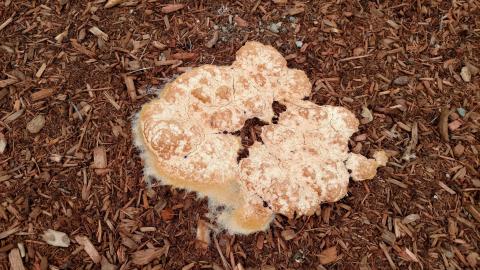What is growing on my mulch?

After extended periods of wet weather, gardeners may be startled to find amorphous clumps of slime covering their bark mulch, lawn, or small garden plants. These fungus look-alikes are actually ancient organisms called slime molds. Despite mold being in its name, slime mold is not a fungus, but rather an ancient lineage of amoebas. Unlike stationary mushrooms that excrete enzymes to break down and absorb their food, slime molds have fluid cell membranes and move around to find sustenance.
The feeding stage of slime mold is what is commonly seen in the garden. Slime molds are broken into two general groups: cellular and plasmodial. Plasmodial slime molds are the type most often found creeping across bark mulch. They start life as a single cell that swims or crawls around a substrate (like mulch, fallen leaves, or a rotting log) looking for food. Eventually the single cell fuses with another single cell to form a giant cell called a plasmodium. Although slime mold doesn’t have a brain, it is capable of moving in the direction of food, which mainly consists of bacteria and fungal spores.
Slime mold thrives in wet conditions. As soon as its substrate is dry and growing conditions are no longer favorable, the plasmodium will condense and form spore producing structures for reproduction. Spores move in the wind or on animals to colonize new areas during the next spell of wet weather.
Though they may look alarming, slime molds are largely harmless in the landscape. They will frequently grow on plants but do not feed on them, only causing damage by blocking light and thereby preventing photosynthesis. The presence of a slime mold only requires intervention if you find its appearance highly disagreeable. Slime molds will disappear on their own when the weather changes, but if you can’t wait, raking them out or scooping them up with a shovel will do the trick. Fungicides are both unnecessary and ineffective. If you’re like me, you’ll enjoy observing this fascinating organism for the brief time it appears in the landscape.
Got questions? The Ask UNH Extension Infoline offers practical help finding answers for your home, yard, and garden questions. Call toll free at 1-877-398-4769, Monday to Friday, 9 a.m. to 2 p.m., or e-mail us at answers@unh.edu.
Related Resource(s)
Do you love learning about stuff like this?
SUBSCRIBE TO Granite State Gardening newsletter
Got questions? The UNH Extension Yard and Garden Infoline offers practical help finding answers for your yard and garden questions.
Call toll free at 1-877-398-4769, Monday to Friday, 9 a.m. to 2 p.m., or fill out webform.
